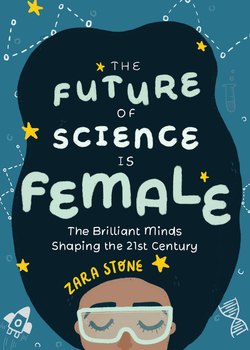Читать книгу The Future of Science is Female - Zara Stone - Страница 6
На сайте Литреса книга снята с продажи.
ОглавлениеThroughout history, badass women have created world-changing advances in science and technology, and right now they’re finally getting the recognition they deserve. #preach
In San Francisco, scientist Etosha Cave developed a machine that sucks carbon dioxide out of the air and turns it into useful plastics and fuel when she was twenty-nine. In Burlington, Canada, seventeen-year-old Riya Karumanchi built the SmartCane, which uses computer vision, haptics, and GPS technology to steer visually impaired people around obstacles. The SmartCane’s vibrations also provide directions. In Connecticut, twenty-nine-year-old Ashley Kalinauskas’s company, Torigen, creates and sells a working cancer vaccine for dogs. Thanks to Ashley’s dedication, hundreds of puppies’ lives have been saved. The list of amazing women in the world right now goes on and on. These scientists and technologists are Black, queer, Asian, disabled, Latina, and white.
We need more of them.
Today, fewer than 4 percent of Latinas and 3 percent of Black women get doctoral degrees in science and engineering. Women make up 20 percent of all undergraduate degrees in engineering, physics, and computer science, but only 11 percent end up working in STEM.
Implicit bias, sexism, and a culture that recommends Bratz dolls to girls and Lego kits to boys play a part in this. Then there are the history books full of white men, which suggest that women aren’t as important or as clever as dudes are. The news is full of stories about cool tech and science startups and tends to focus on the Evan Spiegels, Elon Musks, and Mark Zuckerbergs of the world. When they mention female CEOs, they tend to have fashion- or beauty-related businesses.
We need to know about the Etoshas and Riyas and Ashleys of the world.
The more you hear about people who look and sound like you and are doing great things, the easier it is to realize that you can do that too. I wrote this book so girls and gender-nonconforming and nonbinary people everywhere can learn about people who dealt with similar problems and how they refused to let that rule them.
Why This Matters
In 2007, I interned at a British men’s magazine that covered celebrities, fast cars, and the latest gadgets. It was a competitive internship, and I was excited to work there. I really wanted to make it in journalism; the idea of telling people’s stories and learning about the world seemed like the best job ever. I was one of two girls in the office.
I did everything that people told me would make me a success: arriving an hour early and leaving late and saying yes to everything they asked me to do, from photocopying to typing up notes. I loved the energy of the place. Early on, I signed for a delivery of products from a big electronics brand. There were so many that the editor, a fifty-something white man, said everyone should take one to review—including me. The pile included headphones, a camera, fitness trackers, and more. He asked me what I wanted, and I said I’d love to review the camera. He frowned. “Why not take the electric toothbrush or the hairdryer?” he said. “I think you’d be good with them.”
I nodded—I was trying to be the best intern ever, remember?—and took the electric toothbrush home. A week later I turned in a kickass review, which went in the magazine. Then they gave me a hair straightener to review. A pair of smart scales. A pink laptop. I loved learning about technology, but I hated being put in a box.
I’ve never forgotten that editor. Maybe he genuinely thought those gadgets were best for me. Maybe he didn’t realize how sexist and belittling it felt to be the girl with the pink technology. But so what? It still stung, and it influenced what work I did there and how other people looked at me. His microaggressions stuck with me.
I went on to have a great career in journalism, with a focus on the intersection of culture, technology, and science. I worked as an on-air reporter for ABC News and as a writer for the Washington Post, The Atlantic, Wired magazine, the BBC, and more. I’ve interviewed Steve Wozniak, DJ Tiësto, Cat Deeley, Spice Girl Emma Bunton, Watchmen designer Dave Gibbons, firefighters, mermaids, and more. But I got here in spite of, not because of.
These kinds of microaggressions still happen. In schools across the country, about half as many girls as boys are interested in STEM by eighth grade. That drops to 15 percent by the end of high school. That’s not cool. The world is getting techier and techier, and we need women to be part of its creation. If you’re not in the game, you don’t get a say in what it looks like.
